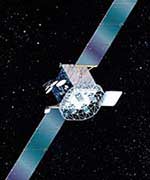
Image credit: Boeing
A Lockheed Martin Atlas III rocket carried a Navy communications satellite onto orbit on Thursday morning. The Atlas III lifted off at 0230 UTC (9:30 pm EST), and it placed the UHF Follow-On (UFO) satellite into an elliptical transfer orbit approximately 32 minutes later. The launch was delayed from Monday because a boltcutter on a liquid oxygen valve needed to be replaced. This was the 68th consecutive successful launch for the Atlas rocket.
A Lockheed Martin-built Atlas III rocket carried a Navy communications satellite into orbit tonight, ending the year on a high note for International Launch Services (ILS), with six successful missions.
The Atlas III launch vehicle left the pad at 9:30 p.m. EST (02:30 Dec. 18 GMT), depositing the satellite into an elliptical transfer orbit about 32 minutes later. The satellite is the 11th in the series called UHF Follow-On (UFO), based on the 601 model built by Boeing Satellite Systems (BSS). Atlas vehicles have launched all 11 UFO satellites, beginning in 1993. The program is managed by the Navy Space and Naval Warfare Systems Command (SPAWAR).
Mark Albrecht, president of McLean-Va.,-based ILS, said: ?Through the UFO program, we have developed a long-standing synergy among the three partners ? BSS as the prime contractor, building the satellites and contracting with ILS for the launches, on behalf of the Navy. ILS and the Lockheed Martin Atlas launch team are proud to have played a part in providing vital communications capabilities worldwide to America?s military.?
Albrecht added: ?SPAWAR had the foresight 15 years ago to model its acquisition of the satellites and launches on largely commercial terms. The UHF Follow-On contract is the largest single contract for the commercial Atlas launch program. It was a tremendous boost to establish Atlas in the early days of its commercial launch business.?
A follow-on program could reunite some of the partners. Lockheed Martin (NYSE:LMT) is leading a team that includes Boeing and General Dynamics, competing to develop the follow-on to UFO called Mobile User Objective System.
Tonight?s rocket, the Atlas III, is one of three Atlas models currently being flown. It is a transitional vehicle between the Atlas II series that has been flying since 1991, and the powerful Atlas V, which made its debut successfully in 2002. The Atlas II, III and V families have achieved 100 percent success through 68 consecutive launches. Just two weeks ago, on Dec. 2, an Atlas IIAS rocket successfully launched another military payload. That mission was for the National Reconnaissance Office, and was launched from Vandenberg Air Force Base, Calif.
The Atlas III builds upon the pressure-stabilized booster design of the Atlas II, but uses the Russian RD-180 main engine with variable thrust control. The Atlas V also uses the RD-180, with a structurally stabilized Common Core Booster. Up to five solid rocket boosters can be strapped on for additional lift capability. Lockheed Martin (NYSE: LMT) developed the Atlas V series for both commercial missions and the U.S. Air Force?s Evolved Expendable Launch Vehicle (EELV) program. ILS? Atlas rockets and their Centaur upper stages are built by Lockheed Martin Space Systems Co. ? Space & Strategic Missiles Operations, at facilities in Denver, Colo.; Harlingen, Texas; and San Diego, Calif.
ILS is a joint venture of Lockheed Martin Corp. and Khrunichev State Research and Production Space Center of Russia. ILS, based in McLean, Va., markets and manages the missions for the Atlas rockets and the Russian Proton launch vehicles. ILS offers the broadest range of launch services in the world along with products with the highest reliability in the industry.
Original Source: ILS News Release
